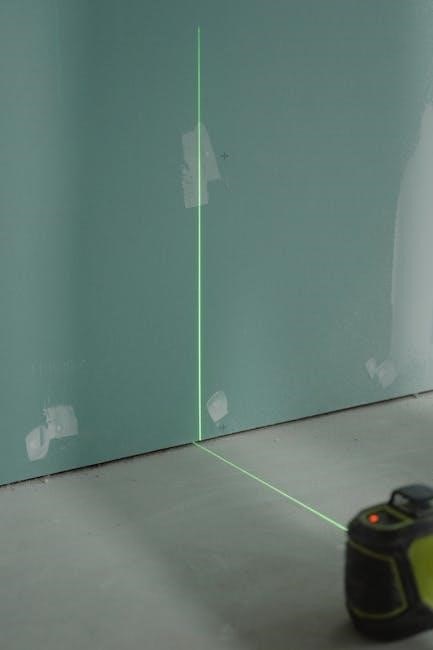A procedural guide is a structured document outlining step-by-step instructions for completing tasks efficiently. It ensures consistency, reduces errors, and enhances productivity by standardizing processes.
1.1. Overview of Procedural Guides
A procedural guide is a detailed, structured document that outlines the steps, actions, and processes required to complete a specific task or set of tasks effectively. It serves as a reference for individuals to follow established protocols, ensuring consistency and accuracy in execution. Procedural guides are commonly used in various industries, including business, healthcare, and technology, to standardize operations and reduce errors. They provide clear, actionable instructions, often accompanied by examples or visuals, to make complex tasks more manageable and understandable for the user.

1.2. Importance of Following a Procedural Guide
Following a procedural guide ensures tasks are performed consistently and accurately. It minimizes errors, enhances safety, and improves efficiency by providing clear, standardized steps. By adhering to the guide, individuals can maintain quality, reduce misunderstandings, and ensure compliance with regulations. It also promotes accountability and helps in training new team members effectively. Ultimately, a procedural guide fosters a structured approach, leading to better outcomes and operational excellence across various industries and scenarios.
1.3. Target Audience for This Guide
This guide is designed for individuals seeking to understand and implement procedural guides effectively. It caters to new hires, experienced staff, and managers needing to standardize processes; The guide is also beneficial for trainers and educators developing instructional materials. Whether you’re in administration, operations, or technical roles, this guide provides clear, actionable steps to enhance efficiency and consistency. It serves as a valuable resource for anyone aiming to improve workflow, reduce errors, and ensure compliance with established standards.

Understanding the Purpose of a Procedural Guide
A procedural guide provides clear instructions to standardize processes, ensure consistency, and achieve desired outcomes. It serves as a reference for training, reducing errors, and enhancing efficiency.
2.1. Defining the Objective
Defining the objective is a critical step in creating a procedural guide. It involves clearly stating the purpose and scope of the document to ensure alignment with its intended use. A well-defined objective helps guide the development process, ensuring that the content remains relevant and focused. It also enables users to understand the goal of the guide and how it applies to their tasks. Establishing a clear objective guarantees that the guide addresses the needs of its audience effectively and efficiently.
2.2. Key Benefits of a Procedural Guide
A procedural guide offers numerous advantages, including enhanced consistency, reduced errors, and improved efficiency. It provides clear direction, ensuring tasks are performed uniformly and correctly. By standardizing processes, it saves time, minimizes confusion, and boosts productivity. Additionally, it serves as a valuable training tool for new team members and ensures compliance with regulations or standards. Regular use of a procedural guide fosters accountability, scalability, and adaptability within organizations, making it an indispensable resource for achieving operational excellence.
- Ensures consistency and accuracy in task execution.
- Reduces errors and minimizes potential risks.
- Enhances efficiency and productivity.
- Serves as a training tool for new employees.
- Supports compliance with industry standards;
- Fosters accountability and scalability.
2.3. Common Scenarios Where a Procedural Guide is Essential
A procedural guide is crucial in high-stakes environments, such as medical procedures, industrial operations, or IT troubleshooting. It ensures safety, accuracy, and consistency in repetitive tasks. For instance, in manufacturing, guides prevent quality control issues, while in healthcare, they safeguard patient care. They are also vital during emergency responses, new employee training, and compliance audits. Additionally, procedural guides are indispensable for complex projects requiring precise execution, such as software development or construction planning, to minimize errors and enhance efficiency.

Steps to Create a Procedural Guide
Creating a procedural guide involves planning, documenting steps, and ensuring clarity. It requires identifying tasks, gathering resources, and organizing information logically for easy understanding and execution.
3.1. Identify the Task or Process
Identifying the task or process is the first step in creating a procedural guide. Clearly define the objective and scope to ensure the guide addresses the specific need. Understand the desired outcome and the audience’s expertise level. Gather initial information by reviewing existing materials or consulting with experts. Determine the complexity of the task and whether it requires detailed step-by-step instructions; List all roles involved and their responsibilities to ensure a comprehensive approach. A well-defined task ensures the guide is practical and user-friendly.
3.2. Gather Necessary Information and Resources
Gathering necessary information and resources is crucial for creating an accurate and comprehensive procedural guide. This step involves reviewing existing documents, consulting experts, and collecting relevant data. Identify tools, materials, and references needed to complete the task. Ensure all information is up-to-date and reliable. Organize the resources logically to support the guide’s structure. This foundation ensures the procedural guide is practical, clear, and aligned with its intended purpose.
3.3. Outline the Steps in a Logical Sequence
Outlining steps in a logical sequence is crucial for clarity and efficiency. Start by identifying the end goal and work backward, ensuring each step builds upon the previous one. Use clear, concise language and number each step to maintain order. Avoid ambiguity by specifying action verbs and necessary details. Consider the reader’s familiarity with the task and include decision points or conditional steps when applicable. Review the sequence to ensure it flows naturally and achieves the desired outcome without unnecessary complexity.
3.4. Include Safety Precautions and Warnings
Incorporating safety precautions and warnings is vital to ensure tasks are performed safely and responsibly. Identify potential hazards and provide clear, concise instructions to mitigate risks. Use visual alerts like warning symbols or bold text to highlight critical safety information. Specify required personal protective equipment (PPE) and emergency procedures. Regularly update safety protocols to align with industry standards and regulations. This ensures compliance and minimizes liability, creating a safer environment for all individuals involved in the process.

Writing Clear and Concise Instructions
Writing clear and concise instructions ensures ease of understanding, reduces errors, and enhances efficiency. It involves using straightforward language, organizing information logically, and making the guide user-friendly for an optimal experience.
4.1. Using Simple and Direct Language
Using simple and direct language is crucial for ensuring clarity in procedural guides. Avoid complex jargon or ambiguous terms that might confuse readers. Clear instructions help users understand each step without misinterpretation. Active voice and present tense make actions more immediate and easier to follow. Break down complex ideas into short, concise sentences. Avoid unnecessary words or phrases that do not add value. This approach ensures that the guide is accessible to all users, regardless of their expertise level, and reduces the likelihood of errors.
4.2. Breaking Down Complex Tasks into Smaller Steps
Breaking down complex tasks into smaller, manageable steps is crucial for clarity and ease of understanding. This approach simplifies intricate processes, making them less overwhelming for users. By dividing tasks into logical, sequential actions, each step becomes more digestible, reducing confusion and errors. It also helps identify key decision points and potential pitfalls. Clear, concise instructions for each sub-task ensure that users can follow along without feeling overwhelmed, ultimately leading to better execution and improved outcomes.
4.3. Incorporating Visual Aids and Diagrams
Visual aids like images, diagrams, and infographics are essential for enhancing clarity in procedural guides. They help users understand complex steps by providing a visual representation of the process. Including screenshots, flowcharts, or illustrations can make instructions more engaging and easier to follow. Visuals should be clear, relevant, and placed near the corresponding text to avoid confusion. High-quality images with annotations can effectively convey information, reducing the need for lengthy descriptions. This approach ensures that users can quickly grasp the instructions, minimizing errors and improving overall efficiency.

Reviewing and Refining the Guide
Reviewing and refining a procedural guide involves thorough examination, incorporating feedback, and ensuring clarity. This step guarantees accuracy, addresses ambiguities, and enhances overall effectiveness.
5.1. Peer Review and Feedback
Peer review involves having stakeholders or colleagues evaluate the procedural guide to ensure clarity, accuracy, and completeness. This step helps identify ambiguities, errors, or missing information. Feedback is collected systematically, focusing on the guide’s effectiveness in addressing the target audience’s needs. Constructive criticism is used to refine the document, making it more user-friendly and practical. Regular peer reviews ensure the guide remains relevant and aligned with organizational goals, fostering collaboration and continuous improvement.
5.2. Editing for Clarity and Accuracy
Editing a procedural guide ensures the content is clear, accurate, and free from ambiguity. This step involves reviewing language for simplicity, removing jargon, and verifying factual correctness. It also ensures consistency in terminology and formatting, making the guide easier to follow. By refining instructions, editors help prevent misinterpretation and errors. Attention to detail is crucial to maintain precision and reliability, ensuring the guide serves its purpose effectively for all users. Thorough editing is essential before finalizing the document for distribution.
5.3. Final Proofreading Before Publication
Final proofreading ensures the procedural guide is error-free and ready for use. Review the entire document for typos, grammatical errors, and formatting inconsistencies. Check that all steps are clear, concise, and logically ordered. Verify that safety precautions, warnings, and critical information are prominently displayed. Ensure consistency in terminology and style throughout the guide. Make sure all visuals and diagrams are properly labeled and positioned. This final review guarantees the guide is professional, accurate, and easy to follow, meeting its intended purpose effectively.

Implementing the Procedural Guide
Implementing a procedural guide involves training, ensuring adherence, and monitoring effectiveness to achieve desired outcomes and promote organizational efficiency.

6.1. Training Staff on the New Procedure
Training staff on a new procedure ensures they understand and can execute tasks effectively. Conduct workshops, provide detailed manuals, and offer hands-on practice. Use visual aids and real-life examples to enhance comprehension. Encourage questions and feedback to address concerns. Monitor progress and offer additional support where needed. This approach fosters confidence, reduces errors, and promotes smooth implementation of the procedural guide across the team. Consistent training ensures everyone follows the same standards, maintaining efficiency and consistency.
6.2. Ensuring Compliance with the Guide
Ensuring compliance with a procedural guide involves regular audits, training sessions, and clear communication. Audits help verify adherence, while feedback loops allow for continuous improvement. Incentives for compliance, such as recognition or rewards, can motivate staff to follow procedures diligently. Consistent enforcement of standards ensures that the guide remains a reliable tool for achieving organizational goals. Regular updates and reminders also keep the team aligned with the latest protocols, fostering a culture of accountability and adherence.
6.3. Monitoring the Effectiveness of the Guide
Monitoring the effectiveness of a procedural guide involves tracking its implementation and impact. Regularly collect feedback from users, analyze performance metrics, and conduct audits to assess adherence. Identify gaps or areas for improvement and document lessons learned. This process ensures the guide remains relevant, efficient, and aligned with organizational goals. Continuous monitoring helps refine the guide, fostering better outcomes and user satisfaction over time.

Updating and Maintaining the Guide
Regular updates ensure the guide remains relevant, incorporating feedback and new information. Maintenance involves periodic reviews, revisions, and archiving outdated versions to keep the document current and accurate.
7.1. Regular Reviews and Updates
Regular reviews and updates are crucial to ensure the procedural guide remains relevant and effective. As processes evolve, the guide must adapt to reflect current practices, industry standards, and new regulations. Scheduled reviews help identify outdated information and incorporate feedback from users. This iterative process ensures clarity, accuracy, and alignment with organizational goals. A dedicated team or individual should oversee the review process, making updates in a timely manner to maintain consistency and reliability.
7.2. Incorporating Feedback from Users
Incorporating feedback from users is crucial for refining and improving a procedural guide. Regularly soliciting input through surveys, meetings, or comment sections ensures the guide remains relevant and practical. Users often provide insights into pain points, ambiguities, or outdated procedures that may have been overlooked. This feedback should be reviewed systematically, prioritized based on impact, and implemented in updates. Maintaining a feedback loop fosters collaboration and ensures the guide evolves to meet changing needs and expectations. This iterative process enhances user satisfaction and guide effectiveness over time.
7.3. Archiving Outdated Versions
Archiving outdated versions of a procedural guide ensures easy access to historical records for reference or compliance purposes. This process involves securely storing past iterations, often in digital or physical archives, while ensuring they are clearly labeled as obsolete to avoid confusion. Regular audits should be conducted to manage archived documents, preventing clutter and maintaining organizational efficiency. Additionally, archiving supports version control, helping users distinguish between current and outdated procedures. This practice promotes accountability and transparency within an organization.

Best Practices for Creating Effective Procedural Guides
Best practices involve using clear language, consistent formatting, and user-centered approaches. Regular updates and feedback ensure relevance and effectiveness, making guides indispensable for success.
8.1. Consistency in Formatting and Terminology
Consistency in formatting and terminology is crucial for a procedural guide to ensure clarity and professionalism. Use uniform fonts, headings, and styles throughout the document to maintain a cohesive appearance. Terminology should be standardized, avoiding ambiguous or varying terms that could confuse readers. Define key terms early in the guide to prevent misinterpretation. Additionally, ensure that numbering, bullet points, and emphasis (e.g., bold or italics) are applied consistently. This uniformity helps users follow instructions more effectively and enhances the guide’s overall reliability.
- Use consistent capitalization and punctuation.
- Apply uniform date, time, and measurement formats.
- Maintain a standard tone and voice throughout.
Regular reviews and updates can help sustain this consistency over time.
8.2. Using Active Voice and Present Tense
Using active voice and present tense in a procedural guide ensures clarity and directness. It helps readers follow instructions without confusion, as the focus remains on the action itself. For example, “Open the valve” is more effective than “The valve should be opened.” This approach maintains consistency and makes the guide easier to understand. It also reduces ambiguity, ensuring that each step is clear and actionable. By adhering to this style, the guide becomes more user-friendly and efficient for individuals following the procedures.
8.3. Providing Alternative Methods When Applicable
Offering alternative methods in a procedural guide enhances flexibility and adaptability. It allows users to choose the best approach based on their specific circumstances or available resources. Including alternatives can address potential obstacles, such as unavailable tools or varying skill levels; Clearly present these options alongside the primary method, ensuring they are equally detailed and easy to follow. This approach promotes problem-solving and ensures the guide remains effective in diverse situations. Regularly update alternatives to reflect new tools, techniques, or user feedback.
Procedural guides are essential for streamlining processes, ensuring consistency, and improving efficiency across various environments, proving to be a vital and universally adaptable tool in modern operations.
9.1. Summary of Key Points
A procedural guide is a vital tool for standardizing processes, ensuring consistency, and reducing errors. It provides clear, step-by-step instructions to achieve specific objectives efficiently. By following a procedural guide, individuals and organizations can enhance productivity, maintain safety, and comply with regulations. The guide is created through careful planning, detailed outlining, and thorough review. Regular updates and feedback ensure its relevance and effectiveness. Ultimately, a well-crafted procedural guide serves as a reliable resource for achieving goals and fostering operational excellence across various scenarios and industries.
9.2. Encouragement to Use the Guide Effectively
Embrace this guide as a valuable resource to streamline processes and enhance productivity. By following its structured approach, you empower yourself and your team to achieve consistent results. Encourage active learning, ask questions, and apply the steps confidently. Remember, this guide is a tool to support your success, so use it regularly to refine your skills and adapt to new challenges. Together, we can foster a culture of efficiency and excellence.


